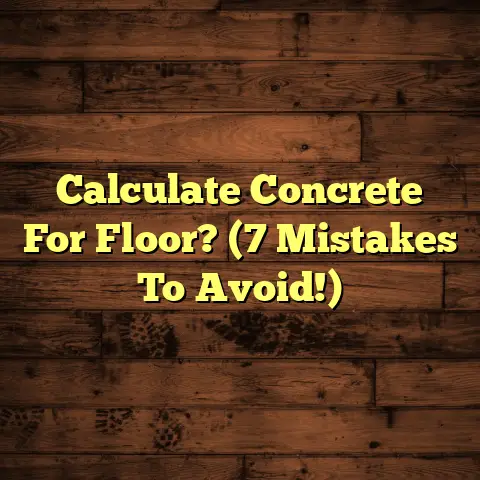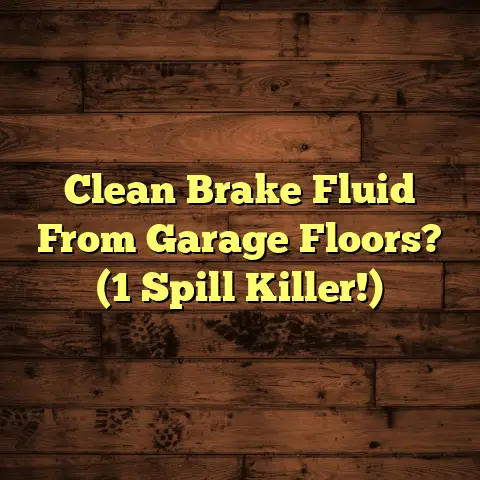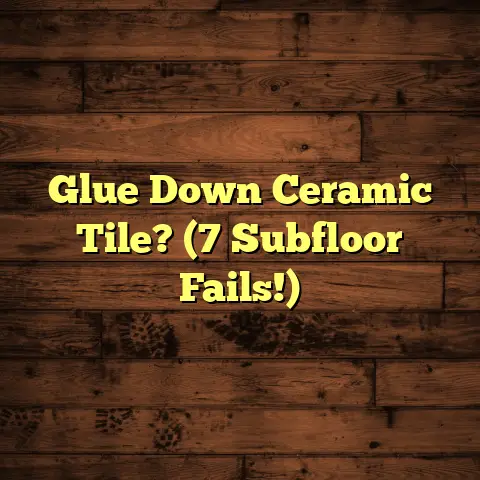Vinyl Flooring: Glue It Down? (1 Adhesion Killer!)
I’ve seen it all, from perfect installs to flooring nightmares.
And you know what? A lot of those nightmares could’ve been avoided with a little knowledge.
Today, we’re diving deep into vinyl flooring, specifically the glue-down method.
It’s a popular choice, especially for smart homes, but there’s a sneaky “adhesion killer” you need to know about.
Let’s get started!
The Rise of Smart Homes and Their Impact on Flooring Choices
Smart homes are all the rage, right? We’re talking voice-activated lights, thermostats that learn your schedule, and refrigerators that order groceries.
It’s all about convenience, efficiency, and integrating technology into our daily lives.
And that extends to flooring!
Modern homeowners want floors that are durable, easy to clean, and look great – all while complementing their smart home aesthetic.
Vinyl flooring has become a top contender because it ticks all those boxes.
It’s versatile, affordable, and comes in a mind-boggling array of designs.
But before you jump on the vinyl bandwagon, let’s talk about installation.
Specifically, the glue-down method and the one thing that can ruin the whole party: moisture.
Section 1: Understanding Vinyl Flooring
Definition and Types of Vinyl Flooring
So, what is vinyl flooring exactly?
Basically, it’s a synthetic flooring material made from polyvinyl chloride (PVC) and other compounds.
It’s layered for durability and often features a printed design layer topped with a protective wear layer.
There are three main types:
- Sheet Vinyl: Comes in large rolls, offering a seamless look. Great for bathrooms and kitchens.
- Vinyl Tiles: Individual squares, allowing for custom patterns and easy replacement.
- Luxury Vinyl Planks (LVP): Mimics the look of hardwood, but with the benefits of vinyl.
What makes vinyl so appealing?
Well, it’s water-resistant (some are even waterproof!), comfortable underfoot, and relatively easy to install.
Plus, it’s budget-friendly compared to options like hardwood or tile.
Popularity and Trends
Vinyl flooring has exploded in popularity in recent years. Why?
A few reasons:
- Improved Technology: Manufacturing advancements have made vinyl more durable and realistic-looking than ever before.
- Affordability: It’s a cost-effective way to get the look of high-end materials without breaking the bank.
- Low Maintenance: Vinyl is easy to clean and doesn’t require special treatments like hardwood.
- DIY-Friendly: Many vinyl products are designed for easy installation, making them a popular choice for DIYers.
As for trends, I’m seeing a lot of:
- Wood-Look LVP: Replicating the warmth and character of hardwood floors.
- Waterproof Vinyl: Ideal for bathrooms, kitchens, and basements.
- Wide Planks: Creating a more spacious and modern feel.
- Textured Surfaces: Adding depth and realism to the flooring.
Section 2: The Installation Process of Vinyl Flooring
Preparation for Installation
Okay, let’s talk about getting ready for your vinyl flooring installation.
Proper preparation is KEY to a successful project.
The most important thing? The subfloor.
Here’s what you need to do:
- Remove Existing Flooring: Rip up any old carpet, tile, or other flooring.
- Clean the Subfloor: Vacuum and scrub the subfloor to remove any dirt, debris, or adhesive residue.
- Level the Subfloor: This is crucial! Use a leveling compound to fill in any cracks, holes, or uneven spots.
- Check for Moisture: We’ll get into this in more detail later, but you need to make sure the subfloor is dry before you start.
A clean, dry, and level subfloor is essential for optimal adhesion and a long-lasting vinyl floor.
Trust me, don’t skip this step!
Adhesive vs. Floating Installation Methods
There are two main ways to install vinyl flooring:
- Glue-Down: The vinyl is adhered directly to the subfloor using a special adhesive.
- Floating: The vinyl planks or tiles click together and “float” over the subfloor without being attached to it.
Here’s a quick comparison:
| Feature | Glue-Down | Floating |
|---|---|---|
| Stability | Excellent | Good |
| Noise Reduction | Better | Slightly Less |
| Cost | Higher (adhesive & professional install) | Lower (easier DIY) |
| Ease of Install | More Difficult | Easier |
| Subfloor Prep | Critical | Important, but less critical than glue-down |
Which method is right for you?
It depends on your budget, DIY skills, and the specific type of vinyl flooring you’re using.
Glue-down is generally recommended for areas with high traffic or moisture, while floating is a good option for simpler projects.
Section 3: The Glue-Down Method
What is Glue-Down Vinyl Flooring?
Let’s zoom in on the glue-down method.
As the name suggests, this involves applying adhesive to the subfloor and then pressing the vinyl flooring into place.
It creates a strong, permanent bond that prevents the flooring from shifting or buckling.
There are different types of adhesives available, including:
- Acrylic Adhesives: Water-based, low-VOC, and easy to clean up.
- Epoxy Adhesives: Stronger and more water- resistant, but also more expensive and harder to work with.
- Pressure-Sensitive Adhesives: Require less curing time and are often used for vinyl tiles.
The best adhesive for your project will depend on the type of vinyl flooring you’re using and the specific recommendations of the manufacturer.
Advantages of Glue-Down Installation
Why choose glue-down? Here are some key benefits:
- Enhanced Stability: The strong bond prevents the flooring from moving, even in high-traffic areas.
- Better Noise Reduction: The adhesive layer helps to dampen sound, making your home quieter.
- Seamless Appearance: Glue-down installations can create a smoother, more seamless look, especially with sheet vinyl.
- Moisture Resistance: When installed properly with the right adhesive, glue-down vinyl can be more resistant to moisture damage.
- Longevity: A properly installed glue-down floor can last for many years with minimal maintenance.
Section 4: The Adhesion Killer: Moisture Issues
Okay, here’s the big one. The thing that can turn your beautiful glue-down vinyl floor into a disaster: moisture.
Understanding Moisture in Flooring
Moisture is the enemy of adhesive.
It can weaken the bond between the vinyl flooring and the subfloor, leading to bubbling, lifting, and ultimately, failure.
Where does this moisture come from?
- Humidity: High humidity levels can cause moisture to seep into the subfloor over time.
- Spills: Accidents happen! Spills that aren’t cleaned up quickly can penetrate the flooring and damage the adhesive.
- Leaks: Leaky pipes, appliances, or roofs can introduce significant amounts of moisture into the subfloor.
- Groundwater: In basements or below-grade installations, groundwater can seep up through the concrete slab.
Signs of Moisture Problems
How can you tell if you have a moisture problem under your vinyl flooring?
Keep an eye out for these signs:
- Bubbling: Raised areas or bubbles in the vinyl flooring.
- Lifting: Edges or corners of the vinyl lifting up from the subfloor.
- Curling: Edges of the vinyl curling upwards.
- Discoloration: Stains or discoloration on the vinyl surface.
- Mold or Mildew: A musty odor or visible mold growth.
- Loose or Hollow Spots: Areas where the vinyl feels loose or sounds hollow when you walk on it.
If you notice any of these signs, it’s important to address the problem quickly to prevent further damage.
How Moisture Affects Adhesive Performance
Let’s get a little technical.
Adhesives work by creating a chemical bond between two surfaces.
Moisture interferes with this process in a couple of ways:
- Weakening the Bond: Moisture can weaken the adhesive itself, making it less able to grip the vinyl flooring and the subfloor.
- Preventing Adhesion: Moisture can create a barrier between the adhesive and the subfloor, preventing the adhesive from forming a strong bond in the first place.
Think of it like trying to glue two pieces of wood together when one is wet.
The glue just won’t stick properly.
I’ve seen countless cases where homeowners installed glue-down vinyl flooring in a basement without properly addressing moisture issues.
Within a few months, the flooring started to bubble and lift, requiring a complete replacement.
It’s a costly mistake that’s easily avoidable.
Section 5: Mitigating Moisture Issues Before Installation
So, how do you prevent moisture from ruining your glue-down vinyl floor?
The key is to address moisture issues before you start the installation.
Pre-Installation Moisture Testing
The first step is to test the moisture levels in your subfloor.
There are a few ways to do this:
- Calcium Chloride Test: This involves placing a container of calcium chloride on the subfloor, sealing it, and then measuring how much moisture the calcium chloride absorbs over a period of time.
- Electronic Moisture Meter: This device uses electrical conductivity to measure the moisture content of the subfloor.
- Plastic Sheet Test: Tape a square of plastic sheeting to the subfloor and leave it for 24-48 hours. If moisture condenses under the plastic, your subfloor is too damp.
What are acceptable moisture levels?
It depends on the type of subfloor and the manufacturer’s recommendations.
Generally, you want to see moisture levels below:
- Concrete: 3-5% moisture content (using a moisture meter) or 5 lbs/1000 sq ft/24 hours (using a calcium chloride test).
- Wood: 12% moisture content or less.
Always consult the manufacturer’s guidelines for the specific vinyl flooring you’re using.
Moisture Barriers and Solutions
If your moisture tests reveal elevated levels, don’t panic!
There are several ways to mitigate the problem:
- Moisture Barriers: These are thin plastic sheets that are installed between the subfloor and the vinyl flooring to prevent moisture from seeping through.
- Moisture Sealants: These are liquid coatings that are applied to the subfloor to seal it and prevent moisture from penetrating.
- Dehumidifiers: Running a dehumidifier in the room can help to reduce humidity levels and prevent moisture from accumulating in the subfloor.
- Ventilation: Ensuring proper ventilation in the room can also help to reduce humidity levels.
- Subfloor Ventilation Systems: For serious moisture problems, you may need to install a subfloor ventilation system to actively remove moisture.
I often recommend using a combination of moisture testing, moisture barriers, and dehumidifiers to ensure a dry and stable subfloor.
Section 6: Common Mistakes to Avoid with Glue-Down Vinyl Flooring
Let’s recap some common pitfalls to steer clear of:
Improper Surface Preparation
Skipping or skimping on subfloor prep is a recipe for disaster.
Make sure to clean, level, and dry the subfloor thoroughly before you start.
Ignoring Manufacturer Guidelines
Always, always follow the manufacturer’s instructions for adhesive application and flooring installation.
They know their products best, and their guidelines are there for a reason.
Underestimating Environmental Factors
Temperature and humidity can significantly impact adhesive performance.
Install vinyl flooring when the room is within the recommended temperature and humidity range.
- Temperature: Most adhesives require a temperature between 65-85°F (18-29°C) for optimal performance.
- Humidity: Keep the humidity level between 30-60% during installation.
Section 7: Conclusion: Making the Right Choice for Your Smart Home
So, there you have it!
Everything you need to know about glue-down vinyl flooring and the dreaded “adhesion killer”: moisture.
Remember, vinyl flooring is a fantastic choice for smart homes.
It offers a winning combination of style, durability, and affordability.
But to ensure a long-lasting and beautiful floor, you must address moisture issues before you start the installation.
Test your subfloor, use moisture barriers, and follow the manufacturer’s guidelines.
By doing so, you’ll avoid costly mistakes and enjoy your new vinyl floor for years to come.
Happy flooring!





